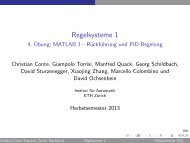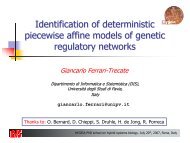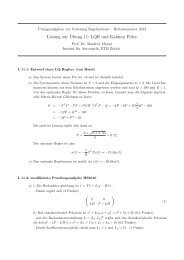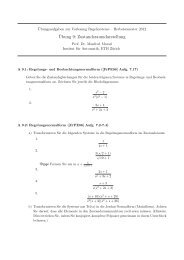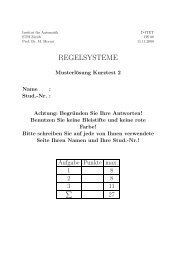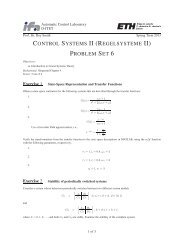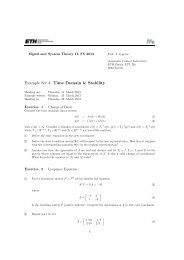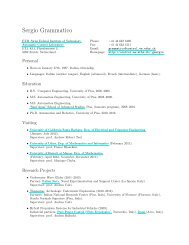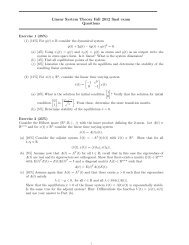Convex Optimization: [0.5ex] from Real-Time ... - ETH Zürich
Convex Optimization: [0.5ex] from Real-Time ... - ETH Zürich
Convex Optimization: [0.5ex] from Real-Time ... - ETH Zürich
You also want an ePaper? Increase the reach of your titles
YUMPU automatically turns print PDFs into web optimized ePapers that Google loves.
<strong>Convex</strong> <strong>Optimization</strong>:<br />
<strong>from</strong> <strong>Real</strong>-<strong>Time</strong> Embedded<br />
to Large-Scale Distributed<br />
Stephen Boyd<br />
Neal Parikh, Eric Chu, Yang Wang, Jacob Mattingley<br />
Electrical Engineering Department, Stanford University<br />
<strong>ETH</strong> <strong>Zürich</strong>, 21/3/2012<br />
1
Outline<br />
<strong>Convex</strong> <strong>Optimization</strong><br />
<strong>Real</strong>-<strong>Time</strong> Embedded <strong>Optimization</strong><br />
Large-Scale Distributed <strong>Optimization</strong><br />
Summary<br />
2
Outline<br />
<strong>Convex</strong> <strong>Optimization</strong><br />
<strong>Real</strong>-<strong>Time</strong> Embedded <strong>Optimization</strong><br />
Large-Scale Distributed <strong>Optimization</strong><br />
Summary<br />
<strong>Convex</strong> <strong>Optimization</strong> 3
<strong>Convex</strong> optimization — Classical form<br />
◮ variable x ∈ R n<br />
minimize f0(x)<br />
subject to fi(x) ≤ 0, i = 1,...,m<br />
Ax = b<br />
◮ f0,...,fm are convex: for θ ∈ [0,1],<br />
fi(θx +(1−θ)y) ≤ θfi(x)+(1−θ)fi(y)<br />
i.e., fi have nonnegative (upward) curvature<br />
<strong>Convex</strong> <strong>Optimization</strong> 4
<strong>Convex</strong> optimization — Cone form<br />
◮ variable x ∈ R n<br />
◮ K ⊂ R n is a proper cone<br />
minimize c T x<br />
subject to x ∈ K<br />
Ax = b<br />
◮ K nonnegative orthant −→ LP<br />
◮ K Lorentz cone −→ SOCP<br />
◮ K positive semidefinite matrices −→ SDP<br />
◮ the ‘modern’ canonical form<br />
<strong>Convex</strong> <strong>Optimization</strong> 5
Why<br />
◮ beautiful, nearly complete theory<br />
◮ duality, optimality conditions, ...<br />
<strong>Convex</strong> <strong>Optimization</strong> 6
Why<br />
◮ beautiful, nearly complete theory<br />
◮ duality, optimality conditions, ...<br />
◮ effective algorithms, methods (in theory and practice)<br />
◮ get global solution (and optimality certificate)<br />
◮ polynomial complexity<br />
<strong>Convex</strong> <strong>Optimization</strong> 6
Why<br />
◮ beautiful, nearly complete theory<br />
◮ duality, optimality conditions, ...<br />
◮ effective algorithms, methods (in theory and practice)<br />
◮ get global solution (and optimality certificate)<br />
◮ polynomial complexity<br />
◮ conceptual unification of many methods<br />
<strong>Convex</strong> <strong>Optimization</strong> 6
Why<br />
◮ beautiful, nearly complete theory<br />
◮ duality, optimality conditions, ...<br />
◮ effective algorithms, methods (in theory and practice)<br />
◮ get global solution (and optimality certificate)<br />
◮ polynomial complexity<br />
◮ conceptual unification of many methods<br />
◮ lots of applications (many more than previously thought)<br />
<strong>Convex</strong> <strong>Optimization</strong> 6
Application areas<br />
◮ machine learning, statistics<br />
◮ finance<br />
◮ supply chain, revenue management, advertising<br />
◮ control<br />
◮ signal and image processing, vision<br />
◮ networking<br />
◮ circuit design<br />
◮ combinatorial optimization<br />
◮ quantum mechanics<br />
<strong>Convex</strong> <strong>Optimization</strong> 7
Applications — Machine learning<br />
◮ parameter estimation for regression and classification<br />
◮ least squares, lasso regression<br />
◮ logistic, SVM classifiers<br />
◮ ML and MAP estimation for exponential families<br />
◮ modern ℓ1 and other sparsifying regularizers<br />
◮ compressed sensing, total variation reconstruction<br />
◮ k-means, EM (bi-convex)<br />
<strong>Convex</strong> <strong>Optimization</strong> 8
Example — Support vector machine<br />
◮ data (ai,bi), i = 1,...,m<br />
◮ ai ∈ R n feature vectors; bi ∈ {−1,1} Boolean outcomes<br />
◮ prediction: ˆb = sign(w T a−v)<br />
◮ w ∈ R n is weight vector; v ∈ R is offset<br />
<strong>Convex</strong> <strong>Optimization</strong> 9
Example — Support vector machine<br />
◮ data (ai,bi), i = 1,...,m<br />
◮ ai ∈ R n feature vectors; bi ∈ {−1,1} Boolean outcomes<br />
◮ prediction: ˆb = sign(w T a−v)<br />
◮ w ∈ R n is weight vector; v ∈ R is offset<br />
◮ SVM: choose w, v via (convex) optimization problem<br />
minimize L+(λ/2)w 2 2<br />
L = (1/m) m <br />
i=1 1−bi(w Tai −v) <br />
+ is avg. loss<br />
<strong>Convex</strong> <strong>Optimization</strong> 9
SVM<br />
w T z −v = 0 (solid); |w T z −v| = 1 (dashed)<br />
<strong>Convex</strong> <strong>Optimization</strong> 10
Sparsity via ℓ1 regularization<br />
◮ adding ℓ1-norm regularization<br />
λx1 = λ(|x1|+|x2|+···+|xn|)<br />
to objective results in sparse x<br />
◮ λ > 0 controls trade-off of sparsity versus main objective<br />
◮ preserves convexity, hence tractability<br />
◮ used for many years, in many fields<br />
◮ sparse design<br />
◮ feature selection in machine learning (lasso, SVM, ...)<br />
◮ total variation reconstruction in signal processing<br />
◮ compressed sensing<br />
<strong>Convex</strong> <strong>Optimization</strong> 11
Example — Lasso<br />
◮ regression problem with ℓ1 regularization:<br />
with A ∈ R m×n<br />
minimize (1/2)Ax −b 2 2 +λx1<br />
◮ useful even when n ≫ m (!!); does feature selection<br />
<strong>Convex</strong> <strong>Optimization</strong> 12
Example — Lasso<br />
◮ regression problem with ℓ1 regularization:<br />
with A ∈ R m×n<br />
minimize (1/2)Ax −b 2 2 +λx1<br />
◮ useful even when n ≫ m (!!); does feature selection<br />
◮ cf. ℓ2 regularization (‘ridge regression’):<br />
minimize (1/2)Ax −b 2 2 +λx2 2<br />
<strong>Convex</strong> <strong>Optimization</strong> 12
Example — Lasso<br />
◮ regression problem with ℓ1 regularization:<br />
with A ∈ R m×n<br />
minimize (1/2)Ax −b 2 2 +λx1<br />
◮ useful even when n ≫ m (!!); does feature selection<br />
◮ cf. ℓ2 regularization (‘ridge regression’):<br />
minimize (1/2)Ax −b 2 2 +λx2 2<br />
◮ lasso, ridge regression have same computational cost<br />
<strong>Convex</strong> <strong>Optimization</strong> 12
Example — Lasso<br />
◮ m = 200 examples, n = 1000 features<br />
◮ examples are noisy linear measurements of true x<br />
◮ true x is sparse (30 nonzeros)<br />
1<br />
0.8<br />
0.6<br />
0.4<br />
0.2<br />
0<br />
−0.2<br />
−0.4<br />
−0.6<br />
−0.8<br />
−1<br />
true x ℓ2 reconstruction<br />
100 200 300 400 500 600 700 800 900 1000<br />
1<br />
0.8<br />
0.6<br />
0.4<br />
0.2<br />
0<br />
−0.2<br />
−0.4<br />
−0.6<br />
−0.8<br />
−1<br />
100 200 300 400 500 600 700 800 900 1000<br />
<strong>Convex</strong> <strong>Optimization</strong> 13
Example — Lasso<br />
1<br />
0.8<br />
0.6<br />
0.4<br />
0.2<br />
0<br />
−0.2<br />
−0.4<br />
−0.6<br />
−0.8<br />
−1<br />
true x ℓ1 (lasso) reconstruction<br />
100 200 300 400 500 600 700 800 900 1000<br />
1<br />
0.8<br />
0.6<br />
0.4<br />
0.2<br />
0<br />
−0.2<br />
−0.4<br />
−0.6<br />
−0.8<br />
−1<br />
100 200 300 400 500 600 700 800 900 1000<br />
<strong>Convex</strong> <strong>Optimization</strong> 14
State of the art — Medium scale solvers<br />
◮ 1000s–10000s variables, constraints<br />
◮ reliably solved by interior-point methods on single machine<br />
◮ exploit problem sparsity<br />
◮ not quite a technology, but getting there<br />
<strong>Convex</strong> <strong>Optimization</strong> 15
State of the art — Modeling languages<br />
◮ (new) high level language support for convex optimization<br />
◮ describe problem in high level language<br />
◮ description is automatically transformed to cone problem<br />
◮ solved by standard solver, transformed back to original form<br />
<strong>Convex</strong> <strong>Optimization</strong> 16
State of the art — Modeling languages<br />
◮ (new) high level language support for convex optimization<br />
◮ describe problem in high level language<br />
◮ description is automatically transformed to cone problem<br />
◮ solved by standard solver, transformed back to original form<br />
◮ enables rapid prototyping (for small and medium problems)<br />
◮ ideal for teaching (can do a lot with short scripts)<br />
<strong>Convex</strong> <strong>Optimization</strong> 16
CVX<br />
◮ parser/solver written in Matlab (M. Grant, 2005)<br />
◮ SVM:<br />
minimize L+(λ/2)w 2 2<br />
L = (1/m) m <br />
i=1 1−bi(w Tai −v) <br />
+ is avg. loss<br />
◮ CVX specification:<br />
cvx begin<br />
variables w(n) v % weight, offset<br />
L=(1/m)*sum(pos(1-b.*(A*w-v))); % avg. loss<br />
minimize (L+(lambda/2)*sum square(w))<br />
cvx end<br />
<strong>Convex</strong> <strong>Optimization</strong> 17
Outline<br />
<strong>Convex</strong> <strong>Optimization</strong><br />
<strong>Real</strong>-<strong>Time</strong> Embedded <strong>Optimization</strong><br />
Large-Scale Distributed <strong>Optimization</strong><br />
Summary<br />
<strong>Real</strong>-<strong>Time</strong> Embedded <strong>Optimization</strong> 18
Motivation<br />
◮ in many applications, need to solve the same problem<br />
repeatedly with different data<br />
◮ control: update actions as sensor signals, goals change<br />
◮ finance: rebalance portfolio as prices, predictions change<br />
◮ used now when solve times are measured in minutes, hours<br />
◮ supply chain, chemical process control, trading<br />
<strong>Real</strong>-<strong>Time</strong> Embedded <strong>Optimization</strong> 19
Motivation<br />
◮ in many applications, need to solve the same problem<br />
repeatedly with different data<br />
◮ control: update actions as sensor signals, goals change<br />
◮ finance: rebalance portfolio as prices, predictions change<br />
◮ used now when solve times are measured in minutes, hours<br />
◮ supply chain, chemical process control, trading<br />
◮ (using new techniques) can be used for applications with<br />
solve times measured in milliseconds or microseconds<br />
<strong>Real</strong>-<strong>Time</strong> Embedded <strong>Optimization</strong> 19
Example — Disk head positioning<br />
replacements<br />
F<br />
◮ force F(t) moves disk head/arm modeled as 3 masses<br />
(2 vibration modes)<br />
◮ goal: move head to commanded position as quickly as<br />
possible, with |F(t)| ≤ 1<br />
◮ reduces to a (quasi-) convex problem<br />
<strong>Real</strong>-<strong>Time</strong> Embedded <strong>Optimization</strong> 20
Optimal force profile<br />
3<br />
2.5<br />
2<br />
1.5<br />
1<br />
0.5<br />
position force F(t)<br />
0<br />
−2 0 2 4 6 8 10 12<br />
t<br />
1<br />
0.8<br />
0.6<br />
0.4<br />
0.2<br />
0<br />
−0.2<br />
−0.4<br />
−0.6<br />
−0.8<br />
−1<br />
t<br />
−2 0 2 4 6 8 10 12<br />
<strong>Real</strong>-<strong>Time</strong> Embedded <strong>Optimization</strong> 21
Embedded solvers — Requirements<br />
◮ high speed<br />
◮ hard real-time execution limits<br />
◮ extreme reliability and robustness<br />
◮ no floating point exceptions<br />
◮ must handle poor quality data<br />
◮ small footprint<br />
◮ no complex libraries<br />
<strong>Real</strong>-<strong>Time</strong> Embedded <strong>Optimization</strong> 22
Embedded solvers<br />
◮ (if a general solver works, use it)<br />
<strong>Real</strong>-<strong>Time</strong> Embedded <strong>Optimization</strong> 23
Embedded solvers<br />
◮ (if a general solver works, use it)<br />
◮ otherwise, develop custom code<br />
◮ by hand<br />
◮ automatically via code generation<br />
◮ can exploit known sparsity pattern, data ranges, required<br />
tolerance at solver code development time<br />
<strong>Real</strong>-<strong>Time</strong> Embedded <strong>Optimization</strong> 23
Embedded solvers<br />
◮ (if a general solver works, use it)<br />
◮ otherwise, develop custom code<br />
◮ by hand<br />
◮ automatically via code generation<br />
◮ can exploit known sparsity pattern, data ranges, required<br />
tolerance at solver code development time<br />
◮ typical speed-up over general solver: 100–10000×<br />
<strong>Real</strong>-<strong>Time</strong> Embedded <strong>Optimization</strong> 23
Parser/solver vs. code generator<br />
Problem<br />
instance<br />
Parser/solver<br />
<strong>Real</strong>-<strong>Time</strong> Embedded <strong>Optimization</strong> 24<br />
x ⋆
Parser/solver vs. code generator<br />
Problem family<br />
description<br />
Problem<br />
instance<br />
Generator<br />
Problem<br />
instance<br />
Parser/solver<br />
Source code<br />
Custom solver<br />
x ⋆<br />
Compiler<br />
x ⋆<br />
Custom solver<br />
<strong>Real</strong>-<strong>Time</strong> Embedded <strong>Optimization</strong> 24
CVXGEN code generator<br />
◮ handles small, medium size problems transformable to QP<br />
(J. Mattingley, 2010)<br />
◮ uses primal-dual interior-point method<br />
◮ generates flat library-free C source<br />
<strong>Real</strong>-<strong>Time</strong> Embedded <strong>Optimization</strong> 25
CVXGEN example specification — SVM<br />
dimensions<br />
m = 50 % training examples<br />
n = 10 % dimensions<br />
end<br />
parameters<br />
a[i] (n), i = 1..m % features<br />
b[i], i = 1..m % outcomes<br />
lambda positive<br />
end<br />
variables<br />
w (n) % weights<br />
v % offset<br />
end<br />
minimize<br />
(1/m)*sum[i = 1..m](pos(1 - b[i]*(w’*a[i] − v))) +<br />
(lambda/2)*quad(w)<br />
end<br />
<strong>Real</strong>-<strong>Time</strong> Embedded <strong>Optimization</strong> 26
CVXGEN sample solve times<br />
problem SVM Disk<br />
variables 61 590<br />
constraints 100 742<br />
CVX, Intel i3 270 ms 2100 ms<br />
CVXGEN, Intel i3 230 µs 4.8 ms<br />
<strong>Real</strong>-<strong>Time</strong> Embedded <strong>Optimization</strong> 27
Outline<br />
<strong>Convex</strong> <strong>Optimization</strong><br />
<strong>Real</strong>-<strong>Time</strong> Embedded <strong>Optimization</strong><br />
Large-Scale Distributed <strong>Optimization</strong><br />
Summary<br />
Large-Scale Distributed <strong>Optimization</strong> 28
Motivation and goal<br />
motivation:<br />
◮ want to solve arbitrary-scale optimization problems<br />
◮ machine learning/statistics with huge datasets<br />
◮ dynamic optimization on large-scale networks<br />
Large-Scale Distributed <strong>Optimization</strong> 29
Motivation and goal<br />
motivation:<br />
◮ want to solve arbitrary-scale optimization problems<br />
◮ machine learning/statistics with huge datasets<br />
◮ dynamic optimization on large-scale networks<br />
goal:<br />
◮ ideally, a system that<br />
◮ has CVX-like interface<br />
◮ targets modern large-scale computing platforms<br />
◮ scales arbitrarily<br />
...not there yet, but there’s promising progress<br />
Large-Scale Distributed <strong>Optimization</strong> 29
Distributed optimization<br />
◮ devices/processors/agents coordinate to solve large<br />
problem, by passing relatively small messages<br />
◮ can split variables, constraints, objective terms among<br />
processors<br />
◮ variables that appear in more than one processor called<br />
‘complicating variables’<br />
(same for constraints, objective terms)<br />
Large-Scale Distributed <strong>Optimization</strong> 30
Example — Distributed optimization<br />
minimize f1(x1,x2)+f2(x2,x3)+f3(x1,x3)<br />
f1 f2 f3<br />
x2<br />
x1<br />
Large-Scale Distributed <strong>Optimization</strong> 31<br />
x3
Distributed optimization methods<br />
◮ dual decomposition (Dantzig-Wolfe, 1950s–)<br />
◮ subgradient consensus<br />
(Tsitsiklis, Bertsekas, Nedić, Ozdaglar, Jadbabaie, 1980s–)<br />
Large-Scale Distributed <strong>Optimization</strong> 32
Distributed optimization methods<br />
◮ dual decomposition (Dantzig-Wolfe, 1950s–)<br />
◮ subgradient consensus<br />
(Tsitsiklis, Bertsekas, Nedić, Ozdaglar, Jadbabaie, 1980s–)<br />
◮ alternating direction method of multipliers (1980s–)<br />
◮ equivalent to many other methods<br />
(e.g., Douglas-Rachford splitting)<br />
◮ well suited to modern systems and problems<br />
Large-Scale Distributed <strong>Optimization</strong> 32
Consensus optimization<br />
◮ want to solve problem with N objective terms<br />
minimize N<br />
i=1 fi(x)<br />
e.g., fi is the loss function for ith block of training data<br />
◮ consensus form:<br />
minimize N<br />
i=1 fi(xi)<br />
subject to xi −z = 0<br />
◮ xi are local variables<br />
◮ z is the global variable<br />
◮ xi −z = 0 are consistency or consensus constraints<br />
Large-Scale Distributed <strong>Optimization</strong> 33
Consensus optimization via ADMM<br />
with x k = (1/N) N<br />
i=1 xk i<br />
x k+1<br />
i<br />
u k+1<br />
i<br />
(average over local variables)<br />
<br />
fi(xi)+(ρ/2)xi −x k +u k i 2 <br />
2<br />
:= argmin<br />
xi<br />
:= u k i +(x k+1<br />
i −x k+1 )<br />
◮ get global minimum, under very general conditions<br />
◮ u k is running sum of inconsistencies (PI control)<br />
◮ minimizations carried out independently and in parallel<br />
◮ coordination is via averaging of local variables xi<br />
Large-Scale Distributed <strong>Optimization</strong> 34
Statistical interpretation<br />
◮ fi is negative log-likelihood (loss) for parameter x given ith<br />
data block<br />
◮ x k+1<br />
i is MAP estimate under prior N(x k −u k i ,ρI)<br />
◮ processors only need to support a Gaussian MAP method<br />
◮ type or number of data in each block not relevant<br />
◮ consensus protocol yields global ML estimate<br />
◮ privacy preserving: agents never reveal data to each other<br />
Large-Scale Distributed <strong>Optimization</strong> 35
Example — Consensus SVM<br />
◮ baby problem with n = 2, m = 400 to illustrate<br />
◮ examples split into N = 20 groups, in worst possible way:<br />
each group contains only positive or negative examples<br />
Large-Scale Distributed <strong>Optimization</strong> 36
Iteration 1<br />
10<br />
8<br />
6<br />
4<br />
2<br />
0<br />
−2<br />
−4<br />
−6<br />
−8<br />
−10<br />
−3 −2 −1 0 1 2 3<br />
Large-Scale Distributed <strong>Optimization</strong> 37
Iteration 5<br />
10<br />
8<br />
6<br />
4<br />
2<br />
0<br />
−2<br />
−4<br />
−6<br />
−8<br />
−10<br />
−3 −2 −1 0 1 2 3<br />
Large-Scale Distributed <strong>Optimization</strong> 38
Iteration 40<br />
10<br />
8<br />
6<br />
4<br />
2<br />
0<br />
−2<br />
−4<br />
−6<br />
−8<br />
−10<br />
−3 −2 −1 0 1 2 3<br />
Large-Scale Distributed <strong>Optimization</strong> 39
Example — Distributed lasso<br />
◮ example with dense A ∈ R 400000×8000 (∼30 GB of data)<br />
◮ distributed solver written in C using MPI and GSL<br />
◮ no optimization or tuned libraries (like ATLAS, MKL)<br />
◮ split into 80 subsystems across 10 (8-core) machines on<br />
Amazon EC2<br />
◮ computation times<br />
loading data 30s<br />
factorization (5000×8000 matrices) 5m<br />
subsequent ADMM iterations 0.5–2s<br />
total time (about 15 ADMM iterations) 5–6m<br />
Large-Scale Distributed <strong>Optimization</strong> 40
Outline<br />
<strong>Convex</strong> <strong>Optimization</strong><br />
<strong>Real</strong>-<strong>Time</strong> Embedded <strong>Optimization</strong><br />
Large-Scale Distributed <strong>Optimization</strong><br />
Summary<br />
Summary 41
Summary<br />
convex optimization problems<br />
◮ arise in many applications<br />
◮ can be solved effectively<br />
◮ small problems at microsecond/millisecond time scales<br />
◮ medium-scale problems using general purpose methods<br />
◮ arbitrary-scale problems using distributed optimization<br />
Summary 42
References<br />
◮ <strong>Convex</strong> <strong>Optimization</strong> (Boyd & Vandenberghe)<br />
◮ CVX: Matlab software for disciplined convex programming<br />
(Grant & Boyd)<br />
◮ CVXGEN: A code generator for embedded convex<br />
optimization (Mattingley & Boyd)<br />
◮ Distributed optimization and statistical learning via the<br />
alternating direction method of multipliers<br />
(Boyd, Parikh, Chu, Peleato, & Eckstein)<br />
all available (with code) <strong>from</strong> stanford.edu/~boyd<br />
Summary 43


![Convex Optimization: [0.5ex] from Real-Time ... - ETH Zürich](https://img.yumpu.com/18678007/1/500x640/convex-optimization-05ex-from-real-time-eth-zurich.jpg)
